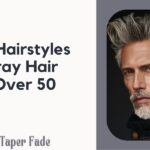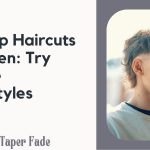If you’ve ever suffered from parched, dry hair, you know how frustrating it is, especially if you don’t know the cause of the problem. Environmental aggressors, overstyling practices, and even what you eat may contribute to these conditions.
How can you tell if your hair is dry? When you touch your hair, it may feel rough, appear dull, or have split ends. During your styling routine, you may also encounter endless frustration as it is prone to breakage and difficult to manage.
To treat existing damage and protect against future stressors, you must take a thoughtful approach to hair care. In order to lay the foundation for healthier locks, a combination of preventative and corrective measures is needed!
Dry hair causes

Let’s first explore how hair structure affects moisture retention and the common causes of dry hair.
Hair Structure
Hair’s outermost layer, called the cuticle, is responsible for protecting the shaft and retaining moisture. A damaged cuticle rises and loses its ability to seal in moisture, resulting in dry skin. The cuticle is what locks in moisture, so maintaining a smooth, intact cuticle is essential.
Common Causes of Dry Hair
Dry hair can be caused by a variety of factors. It is possible for styling tools to remove moisture from your hair and lift the cuticles if they are heated. In the same way, repeated use of chemical treatments such as dyes and relaxers damages your hair cuticles.
Your scalp’s natural oils, or sebum, are essential for your hair’s health, but if they aren’t distributed properly, they can dry out the ends.
The following are some of the most common culprits:
- Excessive heat styling: blow dryers, curling irons, and flat irons.
- Harsh chemical treatments: bleaching, perming, and relaxing.
- Environmental factors: pollution, UV rays, and humidity changes.
- Improper hair care: excessive washing, rough towel drying, and inadequate conditioning.
- Your genes: You may be predisposed to dry hair by your genes.
- Age: Our hair becomes drier as we age.
Also read: Low Taper Fade Haircuts Styles
Preventative measures and daily hair care

In order to prevent dry hair, it is essential to take good care of your hair. Choosing the right products and applying effective techniques will help you maintain your hair’s natural moisture and strength.
Choosing the Right Shampoo and Conditioner
Preventing dryness and brittleness begins with selecting the right shampoo and conditioner. Look for products that are hydrating or moisturizing. You should use a gentle shampoo that is preferably sulfate-free, as harsh detergents can damage your hair.
If you want to attract and retain moisture in your hair, choose conditioners that contain natural oils, shea butter, or panthenol.
You can reduce breakage and damage to your dry hair by using ingredients like hydrolyzed proteins, which reinforces and strengthens the hair shaft. The Hairstyle Edit recommends using reparative treatments (Olaplex is a favorite).
Heat Styling with Caution
Hair can be damaged significantly by excessive heat styling, leading to dryness and breakage. Curling irons and straighteners should always be used with a heat protectant product beforehand.
Your hair will be protected from heat damage with a heat protectant. Whenever possible, use lower heat settings when heat styling and limit it to a few times per week.
Outdoor Activities Tips
Hair can also become dry and brittle from exposure to the sun and wind. Use a UV-protectant spray or a hat if you spend a lot of time outdoors.
Make sure your hair is wet before entering a pool or ocean to prevent it from absorbing too much chlorine or salt. To remove excess chemicals or salt from your hair, rinse it and condition it.
Incorporate Natural Oils Into Your Haircare Routine
It is very beneficial to include natural oils and treatments in your hair care routine to prevent dryness. Moisturizing properties are known to be found in argan oil, jojoba oil, and coconut oil. Pre-shampoo treatments, leave-in conditioners, or even regular conditioners can be used with them.
Jojoba Oil
Helps regulate oil production and mimics natural sebum, making it ideal for both dry and oily hair.
Argan Oil
This oil is rich in fatty acids and Vitamin E, which helps hydrate and nourish dry, damaged hair.
Coconut Oil
Helps tame frizz, reduce breakage, and is easily absorbed.
Also, read Taper vs. Fade
Techniques for washing hair that retain moisture
It is as important to wash your hair correctly as it is to use the right products. You should avoid washing your hair every day to prevent the loss of natural oils and moisture.
To prevent breaking vulnerable strands, wash your hair with lukewarm water rather than hot water.
- Washing Frequency: To preserve natural oils, try washing your hair every 2-3 days instead of every day.
- Water Temperature: Avoid excessive drying by using lukewarm water instead of hot water.
Make use of a deep conditioning hair mask
Anyone with damaged or dry hair should own a deep-conditioning hair mask. Using these masks, you can restore moisture and repair damage to your hair by infusing them with nourishing ingredients. They can usually be used once a week, or even more frequently if necessary.
Get Regular Trims
Maintaining healthy hair requires regular trims. It is not only beneficial to trim split ends that can result from dryness, but it can also prevent further damage and breakage. Trim your hair every six to eight weeks.
Brushing Dry Hair
Detangling knots should begin at the bottom when brushing your hair. Wet hair can also be minimized by using a wide-toothed comb or brush designed specifically for wet hair.
You should use a gentle touch when brushing dry hair, as excessive brushing can lead to further damage. Make your hair look healthier by using a boar bristle brush, which distributes natural oils from the scalp to the ends.
Professional Treatments and Their Benefits
Investing in professional treatments can significantly improve the quality of your hair if at-home treatments are not working.
- Deep conditioning ensures all beneficial nutrients penetrate deep into the hair shaft.
- Hair strands become less frizzy and breakable after a keratin treatment smoothes out the cuticle.
- Salon protein treatments make your hair more resilient by filling in the gaps in its keratin.
Depending on your hair type and concerns, your stylist can recommend the best treatment for you.
Foods, Vitamins, and Supplements for Hair
The health of your hair is heavily influenced by your diet. Hair is strengthened from within by vitamins A, E, and D, iron, protein, carbohydrates, and healthy fats.
If you want to give your hair an extra boost, consider taking collagen and biotin supplements. You’ll see an improvement in the strength and vitality of your hair. You can see an improvement in the health of your hair over time by regularly consuming these nutrients.
Also read: Best Mid Taper Fade Haircut for Men
Managing Curly or Coarse Hair

Hair with coarse or curly structure and lower porosity may require more intensive moisture to prevent it from drying out.
Consider using products containing ingredients such as aloe vera, panthenol, or coconut oil that are specifically designed for your hair texture. As well as retaining moisture, these ingredients provide a protective barrier against environmental stressors.
When blow drying your hair, use a diffuser to minimize frizz instead of heating tools. In order to maintain the integrity of curly or coarse hair, use a heat protector regularly before heat styling.








